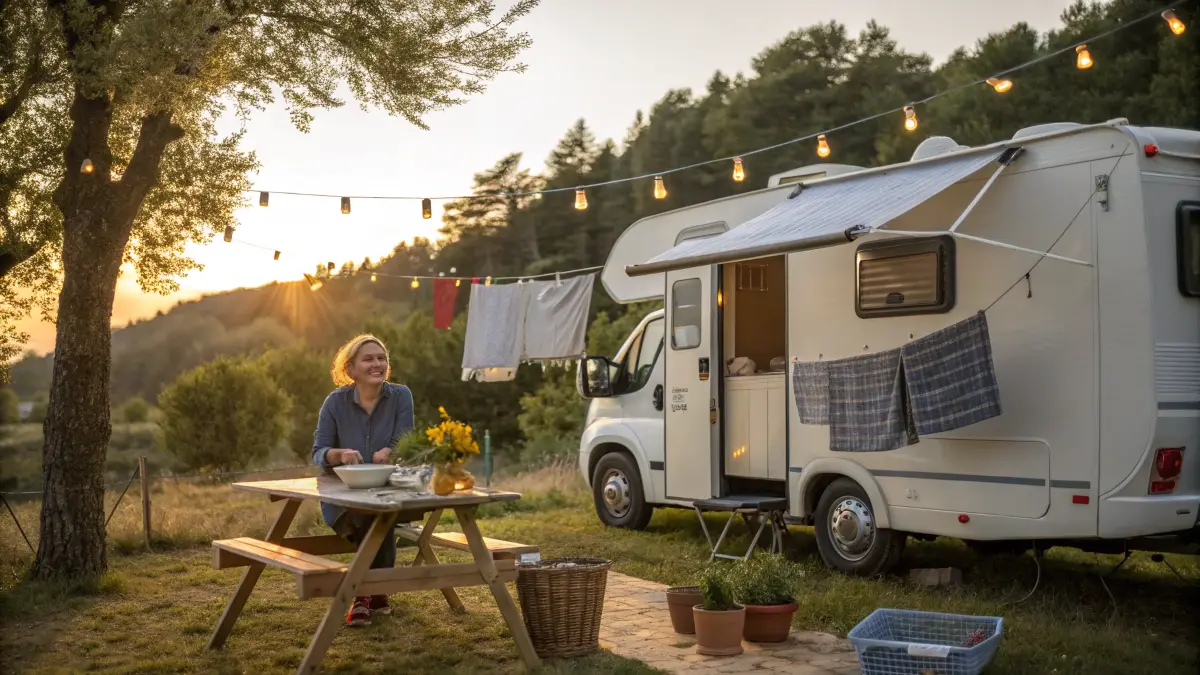Swapping a mortgage for a life of freedom on the open road sounds like a frugal dream, but the reality of 2025 has many full-timers watching their bank accounts dwindle.
You’ve seen the Instagram posts. But you’re also hearing about high fuel prices, overbooked campgrounds, and surprise repair bills. You fear the dream is financially out of reach.
Let’s be honest: the numbers are real. Recent 2025 data shows the average monthly cost for a full-time RV couple is between $1,600 and $5,000. That’s a huge range.
The good news? You can control which end of that range you land on. This isn’t just a list of “travel less.” This is a 13-point action plan. You will learn to strategically slash accommodation fees, master your fuel budget, and use modern tech for frugal RV living. We’ll show you exactly how to cut costs while RVing full time.
Slash Your #1 Expense: The “Big 3” Accommodation Savers
Let’s attack the biggest budget item first: where you park your rig. This section targets camping fees, which are your largest and most controllable expense.
1. Master the Art of Boondocking

Boondocking is free, off-grid camping. You park on public land without water, electric, or sewer hookups. You can find great spots on Bureau of Land Management (BLM) land and in National Forests.
But “free” camping isn’t truly free. It requires an upfront investment to be comfortable. To stay off-grid for weeks, you need a good power system. Solar panels and lithium batteries are key. They save you money on generator fuel and let you stay in one spot longer.
Getting good at boondocking is the fastest way to cheap RV living tips. It can easily save you $500 to $1,200 per month in campground fees. That $1,200 saved per month pays for your solar setup in just a few seasons. From then on, it’s pure savings.
2. Leverage Campground Memberships Strategically

For the times you need hookups, don’t pay the high nightly rate. Use a strategy with memberships. No single membership is a perfect fit. The goal is to build an “arsenal” of options so you never have to pay the full walk-up price.
- Thousand Trails: This is a system of campgrounds. It’s a big cost upfront, but if you use it a lot, your nightly cost can get close to $0. It’s best for people who like to stay in one park system for weeks at a time.
- Harvest Hosts / Boondockers Welcome: These are perfect for unique overnight stays. You park at spots like wineries, farms, or even private driveways. It’s not a “campground” for a week-long stay. It’s a way to avoid a $50/night fee on a long travel day.
- Passport America: This card gets you 50% off at participating campgrounds. It’s great for filling gaps between stays. Just be sure to check for “blackout dates” when the discount doesn’t apply.
RV Camping Memberships
Thousand Trails
Best for long stays (weeks). Pay a big cost upfront, but your nightly cost can get close to $0.
Harvest Hosts
Perfect for unique overnight stays (wineries, farms) to avoid campground fees on long travel days.
Passport America
Get 50% OFF at campgrounds. Great for filling gaps between stays. Just check for blackout dates!
The best plan is to use a combination of all three. Use Harvest Hosts for travel days, Passport America for short stops, and Thousand Trails for longer stays.
3. Consider Workamping to Eliminate Rent

Want to completely eliminate your rent? Try workamping. This is when you trade work for a free Full Hookup (FHU) site. You might work the front desk, clean, or do light maintenance.
Many people work 20 hours a week at a KOA or state park. In return, they get their site for free and often an hourly wage on top of it. This is a huge lifestyle change, but it provides total budget stability. This is the ultimate way to cut costs while RVing full time on accommodation. You can find these jobs on sites like Workamper.com.
Tame Your Travel Budget: Move Smarter, Not Harder
After camping fees, your travel style is the next biggest money-pit. The solution is simple: move smarter.
4. Travel Slower (The “Monthly Rate” Hack)

Moving every few days is a budget killer. You pay high nightly rates and burn a ton of fuel. The 1 tip from almost every full-time RVer is to travel slower. Stay in one place for a month or more.
Here’s the math: a nightly rate might be $60. That’s $1,800 for a month. But the monthly rate at that same park could be just $700. By staying put, you just saved over $1,000. Plus, your fuel bill for that month drops to $0.
This also lets you explore an area deeply. You find the local parks and free events. That makes it a great cheap RV living tip for entertainment, too.
5. Become a Fuel-Saving Guru

Fuel is a massive, painful expense. You can’t control the price per gallon, but you can control how many gallons you use. Use tech to your advantage. These two apps are essential:
RV Savings: Apps That Pay Off!
GasBuddy
Check prices on your route. Driving a few minutes can save 30 cents/gallon. Adds up fast for big rigs!
Upside
Get cash back on fuel purchases you were already making. It’s free money for your tank!
You also need to change your driving habits. Plan efficient routes to avoid backtracking. Always check your tire pressure before you roll. And most importantly, slow down. Driving 60 mph instead of 70 mph can improve your fuel economy by 15%.
6. Learn DIY Maintenance (The $150/hr Saver)

Things will break. That’s a fact of RV life. And RV repair shop labor rates are high, often $150-$200 per hour.
You must have a maintenance budget. Plan for $200-$300 every single month for repairs and upkeep. If you don’t spend it one month, save it. You will need it later.
The best way to save is to do it yourself. Use “YouTube University.” You can learn to reseal your own roof ($20 in caulk vs. $500 for a pro). You can fix a leaky faucet, troubleshoot your water heater, or replace a light. Every time you fix something yourself, you’re not just saving $150/hr. You’re also saving the time and fuel it takes to drive to a dealer and wait. This skill is key to how to save money full time RVing.
Optimize Daily Operations with Frugal Tech
The most successful frugal RVers use technology. In 2025, your smartphone is your best money-saving tool.
7. Use Frugal RVing Apps to Find Everything

This is about more than just finding campgrounds. It’s about finding free resources. This “app stack” works together. You find a free spot on Campendium, route yourself with RV Life, and confirm you can work with SpeedTest.
- Campendium / iOverlander / The Dyrt: Use the map filters on these apps. You can filter for “Free Camping,” “Dump Stations,” and “Potable Water.” Why pay a campground $20 to dump when there’s a free station two miles away?
- RV Life (RV Trip Wizard): A paid subscription here is cheaper than a new roof. This app plans RV-safe routes. It keeps you away from low bridges and steep mountain passes. A costly detour or accident will destroy your budget.
- SpeedTest: If you work remotely, this app is vital. Before you unhook, test the campground Wi-Fi and your cell signal. There is nothing worse than setting up camp only to find you have no service for work.
8. Install Water-Saving Upgrades

When you’re boondocking, your limiting factor is often your water tanks. When your gray tank is full or your fresh tank is empty, you have to move. Moving costs gas and time.
To boondock longer, you must conserve water. Extending your boondocking from 7 days to 14 days cuts your ‘moving’ costs in half. The best way is an Oxygenics (or similar) low-flow showerhead.
It uses a fraction of the water but still feels like a good shower. Also, learn to take “Navy showers” water on to get wet, water off to soap up, water on to rinse.
9. Optimize Your Internet Setup

In 2025, internet is not a luxury. It’s a utility, especially for remote work. But paying for spotty, expensive campground Wi-Fi is a waste of money.
A good setup is vital for how to save money full time RVing. Use a combination of mobile hotspots. This could be T-Mobile Home Internet, a Verizon Jetpack, or Starlink. Before you go, check the cell coverage maps on apps like Campendium. A reliable connection means you never have to pay for a coworking space.
Master Frugal Lifestyle Habits on the Road
Finally, let’s look at the small, daily decisions that add up to big savings.
10. Cook More (and Smarter)

Eating out is a budget-killer. It’s tempting after a long travel day, but it will destroy your food budget. You have a kitchen use it. But you also need to shop smart.
- Shop at budget grocers like Aldi and Grocery Outlet whenever you see one.
- Stock up in bulk before you go to a rural or tourist town. Groceries in popular or remote areas can be 30% more expensive. Plan ahead.
What’s a real budget look like? The full-time RV blog “Journey With The Gs” reported spending $547 on groceries in May 2025. This is a realistic number to aim for if you are careful.
11. Find Free Entertainment

It’s easy to spend $200 on tickets to a tourist trap. Your new backyard is full of free fun.
RV Adventures: Fun & Free!
Explore Nature
Hike, bike, and kayak. Use the AllTrails app to find local routes.
Community Events
Visit free farmer’s markets, concerts, or parades. Check the town’s website!
Reciprocity Membership
Pro-Tip: An annual pass to your local science center might get you free entry elsewhere!
12. Buy Used Gear

You’ll always need something a new camping chair, a sewer hose, an outdoor rug. Never buy it new. The RV community is always upgrading. This means there is a huge market for high-quality used gear.
Join local “Buy Nothing” groups on Facebook for the area you’re staying in. You’ll be amazed at what people give away. Also, use Facebook Marketplace. You can find anything from a new sewer hose to a bike rack for 50% off.
13. Re-Evaluate Your Insurance (Health & RV)

These are the hidden costs that can sink you. Don’t “set it and forget it.”
- RV Insurance: You must have a Full-Time RV policy. A standard auto/RV policy is not enough and won’t cover your belongings or liability. Shop for new quotes every single year.
- Health Insurance: This is the big one. Your old plan may not cover you out-of-state. Explore all your options. This includes ACA marketplace plans, private plans, telehealth services for minor issues, and health-share programs. (Be careful: health-share programs are not traditional insurance but can work for some).
Conclusion
As you can see, the key to frugal RV living in 2025 isn’t about giving up comfort it’s about being strategic.
It means swapping expensive campgrounds for free boondocking, traveling slower to unlock monthly rates, and becoming a savvy DIYer.
The $5,000/month horror stories don’t have to be your reality. Start by implementing just one of these tips today.
.

